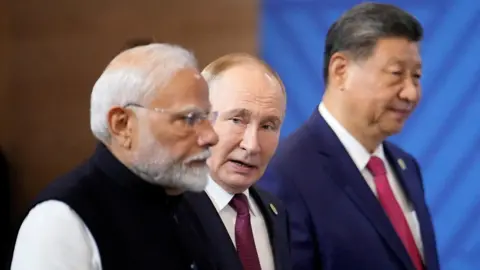Russian oil forges closer ties between Moscow, Beijing and New Delhi at Tianjin SCO summit
Leaders of Russia, China and India met in Tianjin as discounted Russian crude and shared friction with Washington deepen strategic and economic engagement.
Leaders of Russia, China and India used a meeting at the Shanghai Cooperation Organisation summit in Tianjin to display growing solidarity driven in large part by energy ties and shared tensions with the United States.
Monday’s gathering gave Russian President Vladimir Putin a direct opportunity to engage with his country’s two largest oil customers, at a time when Moscow has pivoted to Asia after Western sanctions over its 2022 invasion of Ukraine reduced access to traditional markets. India and China increased purchases of Russian crude in the years since, attracted partly by lower prices following those sanctions and export restrictions.

Since 2022, the pattern of trade has shifted as Moscow secured buyers in Asia while Beijing and New Delhi sought to strengthen energy security and diversify supplies. Analysts say the alignment has moved beyond spot purchases. The leaders’ meetings — they had previously convened in Kazan last year — have underscored efforts to deepen political and economic ties and to institutionalize cooperation through forums such as the SCO.
The three countries also share a common point of friction with the United States. Washington has imposed sanctions on Russia and threatened broad tariffs and penalties on partners that enable Moscow’s war economy. India has faced what officials describe as some of the highest duties imposed by Washington in response to its oil purchases from Russia. China has been negotiating with the United States over measures that could avert sweeping tariffs or other penalties tied to its purchases of Russian crude.
The Tianjin meeting spotlighted how energy trade is intersecting with geopolitics. For Moscow, dependable buyers in Asia have softened the economic blow of Western restrictions and provided leverage to sustain exports. For China and India, access to discounted Russian oil has been one component of a wider strategy to secure energy supplies on competitive terms amid global market volatility.
Observers say the SCO summit provides an institutional backdrop for these alignments, allowing members to promote an alternative to Western-led frameworks for trade and security. The forum’s agenda has increasingly been read as a challenge to U.S. influence in regions stretching from Central Asia to South Asia and the Indo-Pacific, a trend that officials and analysts say has been accelerated by the diplomatic realignments since 2022.

Despite the closer ties, the relationships among Moscow, Beijing and New Delhi are complex and not without limits. India and China both maintain significant economic and strategic relationships with Western countries and pursue independent national interests. New Delhi, in particular, balances its energy imports from Russia with longstanding defence ties and strategic partnerships with Western nations.
Trade statistics since 2022 show rising volumes of Russian crude shipments to Asian markets, and energy analysts say those flows have reshaped global trade patterns. The diplomatic exchanges at Tianjin reaffirmed that energy — especially oil — remains central to the evolving relationships among the three capitals, even as broader cooperation spans infrastructure, trade and regional security discussions.

The summit did not produce an immediate, formal alignment that displaces existing alliances, but it reinforced a trajectory of closer engagement grounded in mutual economic benefit and common concerns about U.S. policy. Analysts and diplomats will watch subsequent meetings and any concrete agreements that emerge from SCO mechanisms to assess whether the pattern of closer ties produces longer-term strategic convergence or remains a transactional arrangement driven mainly by energy trade.